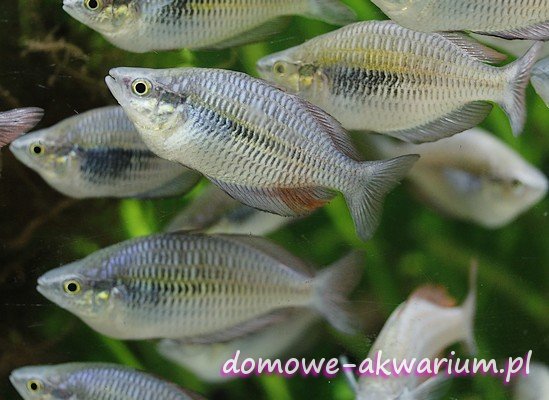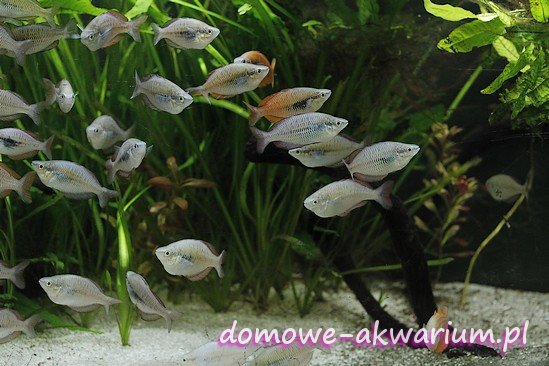
| Species | Goldie River Rainbowfish |
|---|---|
| Other names | Lake Wanam Rainbowfish |
| Latin Name | Melanotaenia Parva |
| Family | rainbowfishes |
| Origin | Azja |
| Length | 10,0 cm |
| Temperature | 24 - 26°C |
| Water Hardness | medium hard |
| pH | 6,5 - 7,5 |
| Aquarium Size | 150 L |
| Food | live, frozen, dry |
Goldie River Rainbowfish, Lake Wanam Rainbowfish
A freshwater species, endemic to Lake Kurumoi, located in West Papua, Indonesia - on a narrow isthmus connecting the Vogelkop Peninsula with the rest of Papua New Guinea. It is a small mountain lake with turbid water, a muddy shore, richly overgrown with aquatic vegetation. The species is endangered due to the drying up of the lake.
The species is characterised by a torpedo-shaped body with variable colouration, which depends largely on the time of day and the position occupied in the group. It seems that the fish colour most intensely in the morning and evening hours, and in the meantime their colour is pale-grey. The dominant male is always the most colourful – orange-red, practically all over the body and fins. The hallmark of the species is a dark spot/stripe running along the lateral line (wide and clearly visible in the front part) and a yellow iris of the eye. Like all Melanotaenia parva rainbowfish, it has two dorsal fins, large scales. Females are less colourful (their bodies are greyish-yellow) and more slender compared to males.

An active, peaceful and schooling fish. When selecting a group of fish, we should have a majority of females. Fish establish hierarchy in the group, with the dominant male always being more vividly coloured compared to the rest of the fish. This species can be kept in a community aquarium with other fish of similar size and temperament. Fish swim at all levels of the tank.
Melanotaenia parva prefers spacious aquariums - longer than higher. Diffused light will be advantageous, a large amount of plants on the sides and in the background of the tank, free spaces for free swimming, fine and light substrate.

An oviparous species, which we should breed in a separate tank. Previously, fish are fed abundantly in the general tank (we can separate females from males). The ready to spawn pair (the female will have a strongly rounded belly, the male will colour more intensely than usual) we transfer to a previously prepared aquarium. Spawning lasts a few days - eggs are laid daily in batches, with the most eggs being laid on the first day and the fewest on the last. The female scatters the eggs among the plants. Parents do not take care of the spawn and fry - they eat them. Therefore, they should be immediately caught after laying and fertilizing the eggs. The fry hatch after about 1-2 weeks.